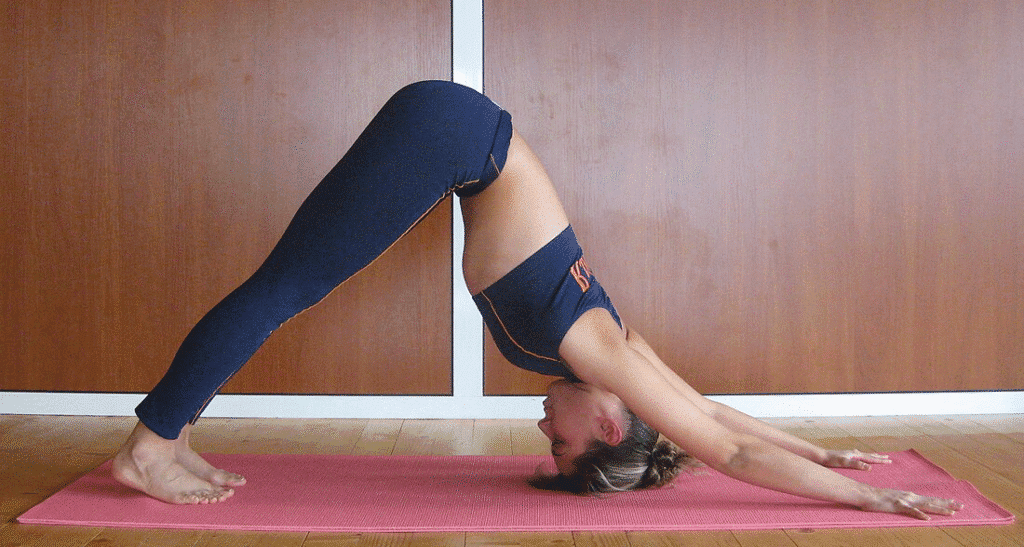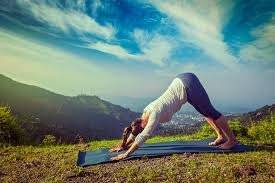Goa is a place. The name brings to mind sunny, free-spirited environments, tropical beaches, and palm trees bending in the sun—the laid-back vibe and nightlife are realistic for anywhere in the world. The small state on the western coast of India has quietly become one of the most fundamental and accessible regions for yoga and spiritual exploration, where practitioners can often be seen perfecting downward dog on the sandy shores.
Goa offers a unique blend of authentic ingredients for pilgrims of all backgrounds to deepen their practice, undergo teacher training, or simply luxuriate in a healing vacation.
Western-friendly facilities, Indian culture, and a deeply healing natural setting. Here, the infinite Arabian Sea meets the old Eastern knowledge, establishing an ideal environment for change.
Why Goa is Ideal for Downward Dog Yoga Training & Retreats: Climate, Energy, Culture, Nature
Goa is a uniquely perfect place to practice downward dog yoga due to an incredible mix of local culture, energy, climate, and stunning natural scenery.

1. Natural Rhythms and the Healing Environment
Goa’s climate is tropical monsoon, meaning it is a pleasant break from colder weather during the peak tourist rain from around October to March.
Perfect Weather: The “high season” weather consists of clear blue skies, pleasant temperatures ranging from the low 70s to high 80s Fahrenheit, and a lovely, cool sea breeze. Daily practice of downward dog yoga happens easily amidst the temperate climate of the high season, and almost naturally allow for sunrise beach meditations and open-air shala sessions without the usual excessive heat.
Proximity to the elements is one of the wonderful advantages of Goa since it is surrounded by the Arabian Sea. Doing yoga while listening to the rhythmic sounds of the waves is profoundly meditative and grounding. Also, a lush tropical environment is an essential part of deep yogic practice. The bright colors of flowers, palm groves, and abundance of birds help to bring energy to the senses and calm the nervous system.
2. A Unique Blend of Energy and Culture
After over 450 years of Portuguese control, Goa has forged a unique, open, and varied culture that is particularly welcoming to foreign visitors.
It has roots in Catholic and Hindu traditions, but its culture is a clear expression of spiritual seeking and tolerance.
From its 1960s and 70s Bohemian roots, it has become a melting pot including several kinds of healing from Ayurveda and Reiki to several sorts of Hatha and Vinyasa yoga live together amicably.
The non-striving approach fundamental to downward dog yoga is reflected in the Goan idea of susegad—a calm, happy ease. This deliberate, gentle speed lets practitioners step outside of the Western hurry and really be present, therefore enhancing deeper concentration throughout their training.
North: Arambol and South: Palolem/Agonda each provide a unique taste. Yoga centers While the south is usually calmer, more immaculate, and appropriate for deep, quiet meditation—perfect for intense ashram life, Arambol is bohemian and active.
3. Practical Accessibility
For international travelers, Goa is surprisingly simple to negotiate in contrast to many other remote spiritual destinations in India. Good infrastructure, generally spoken English (owing to the tourism and colonial past), and lots of dependable means of transport (taxis and scooters) take away most of the logistical friction, allowing them to completely concentrate on their training.
Things to Pack for Ashram Life / What to Expect in Terms of Weather, Surroundings, Culture During a Downward Dog Yoga Immersion
Packing for a Goa retreat or training calls for a deliberate approach, balancing simplicity with practicality. Ashram life is about eliminating the superfluous, but comfort in the surroundings is critical.
Essential Packing List for a Downward Dog Goa Yoga Immersion
| Category | Recommended Items | Notes |
| Clothing | Lightweight, loose cotton clothing | Linen and cotton are best. Shoulders and knees covered for temples/villages. |
| Yoga Wear | 3–4 sets of quick-dry yoga clothes | Expect to sweat! Quick-dry is essential for humid weather. |
| Footwear | Flip-flops/sandals, one pair of walking shoes | You’ll live in flip-flops. Walking shoes only needed for off-day excursions. |
| Safety/Health | Mosquito repellent (high DEET/natural), Sunscreen (high SPF) | Essential for dawn/dusk practice and beach time. |
| Ashram Life | Headlamp/small torch, Water bottle (reusable) | Power cuts can happen; the torch is crucial. Avoid single-use plastic. |
| Personal Care | Hand sanitizer, basic first-aid kit, Stomach medication | Necessary for street food and general hygiene. |
| Extras | Light shawl/scarf, Universal travel adapter, Journal | Shawl is useful for covering up in temples and on cooler evenings. |
What to Expect:
- Simple and communal: Ashram life centers on simplicity. Though often twin-sharing rooms with connected, workable bathrooms, accommodation is typically simple but immaculate. Meals are typically vegetarian, healthy, and communal in nature, which contributes to a strong sense of community and seva (selfless service). For satsang (community gathering) and pranayama (breathwork) followed by the longer asana session as the sun rises, be prepared for early rises likely before dawn.
- Heat and Humidity: Although this time of year will be nice, there may still be extreme humidity. Our top priority will be hydration!
- Expect sounds of village life – temple bells, roosters crowing, dogs barking – to intermingle with your sleep and practice. the constant sound of the ocean or the jungle. This will then be part of a meditation.
- Cultural Sensitivity: Goa is a liberal place, but it is still India. Modest clothing will be valued and respected, especially when meeting locals or going to temples.
Staying Safe & Healthy: Travel Tips, Acclimatization, Food, Water
In order to be both healthy and mentally calm is essential for a great downward dog yoga trip. Some precautions can guarantee a trip that is comfortable, enjoyable, and safe.

1. Water and Hydration
The most basic advice is this: NEVER drink water from the faucet.
Only use water that is bottled and has a seal on the bottle (check the seal!). Use water supplied by your retreat or ashram if they are trusted to have a reverse osmosis (RO) purification process.
Be careful of ice from unknown restaurants. Peel all fruit, even grapes, although they are acceptable at nice hotels/ashrams. Unless you completely trust the source, stay away from salads washed in tap water.
2. Food and Hygiene
Considering the emphasis of ashram life, you will be mostly consuming basic, vegan food. The stomach often finds this the safest and simplest way to adjust. Dal, rice, and vegetable curries are the foundation of the cuisine.
Goan street food is tasty, yet move with care. Only eat from vendors that make the meal in front of you, have high turnover, and whose food is clearly scorching hot.
Frequently wash your hands, especially before dinner. Always keep and use hand sanitizer.
3. Health and Acclimatization
Take your time: The trip, the heat, and sudden shifts in food consumption put stress on the body. Do not jump immediately into vigorous yoga classes. Give yourself a few days to adjust to the time differences and the conditions.
Prevent “Delhi Belly” by taking prescription or reputable over-the-counter medications (Cipro/Azithromycin for domicile’s diarrhea, prescribed by the doctor). Start taking probiotics weeks before the trip to boost your gut flora.
Malaria, dengue, and Chikungunya are possible risks, especially during the shoulder seasons. Apply repellent during peak mosquito times (early morning and at dusk), and have air conditioning or proper mosquito nets where you are staying.
4. Safety and Transportation
A popular way to get around, renting a scooter can be dangerous given the unpredictable traffic. This is a method of transport only to be taken on by confident, experienced drivers, even more so if you have an international driving license, to ensure safety, and always wear a helmet.
Taxis and Rickshaws: If you take an unmetered cab or rickshaw, negotiate the price before boarding. You can use apps like Goa Miles, Goa’s official taxi app, for fixed prices and a slightly safer experience.
Despite also being relatively safe, be aware of your belongings in large crowds or at the beach. Solo female travelers should follow the same precautions as in any other country, especially at night.
Off-Days & Exploring: Beaches, Local Culture, Food, Markets
Although yoga is the main emphasis, taking an ‘off-day’ to discover the enchantment of Goa is critical for striking a balance between demanding training and absorbing the local vibe.
1. The Beaches: North vs. South
For water activities and mainstream tourism, famous beaches like Anjuna (for its Wednesday Flea Market and bohemian vibe) and Baga/Calangute offer North Goa (Action & Vibe). plenty of activity and great energy. Well-known for sound therapies and ecstatic dancing, Arambol has a more mystical/hippie vibe.
The calmest locations in South Goa: Nature and Tranquility For swimming and sunbathing, Palolem is a beautiful crescent-shaped beach. Known for its calm and conservation initiatives, Agonda is protected. These places invite reading and calm contemplation.
2. Cultural Immersion & History
The past of Goa goes beyond its coastline.
A UNESCO World Heritage Site, this rare area encapsulates a stunning collection of remnants from the Portuguese period, including the Basilica of Bom Jesus, which contains the relics of St. Francis Xavier. The experience of European architecture in a tropical environment is a strong one.
Explore the lively local fruit and vegetable markets in places such as Mapusa, or the Saturday Night Market in Arpora. They are a sensory overload and provide an authentic experience of Goan culture: a riot of colour, spices, and local life.
3. Food Exploration
Goan cuisine is a distinctive fusion of Portuguese, Indian, and tropical influences.
Before you leave, be sure to sample authentic Goan fish curry, prawn balchão, and the famous Goan bread (pão).
The Goan dessert Bebinca – a layered coconut cake – is also worth a taste, along with the refreshing coconut water that is readily available!
For a welcome shift from classic Indian food, the yoga hubs of Goa are stocked with healthy cafes that offer some fantastic smoothie bowls, fresh juices, and Western-style health food.
Goa is a whole experience fit to the holistic path of downward dog yoga; it’s not just a place. It provides the committed structure of an ashram, the lively energy of an international community, and the deep serenity of a tropical heaven. Coming prepared, remaining safe, and embracing the susegad attitude will help you to find Goa to be the ideal cauldron for deepening your practice and finding your actual self.






